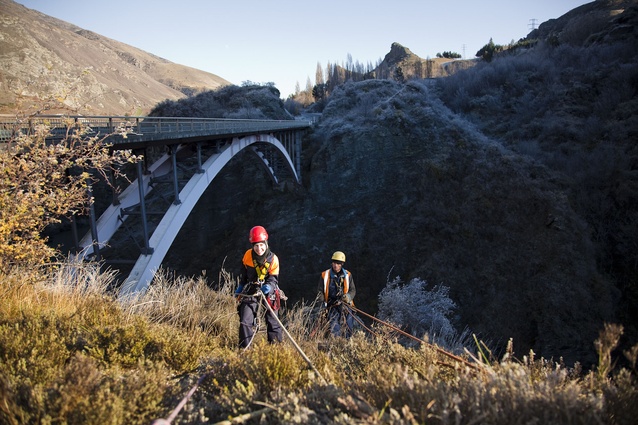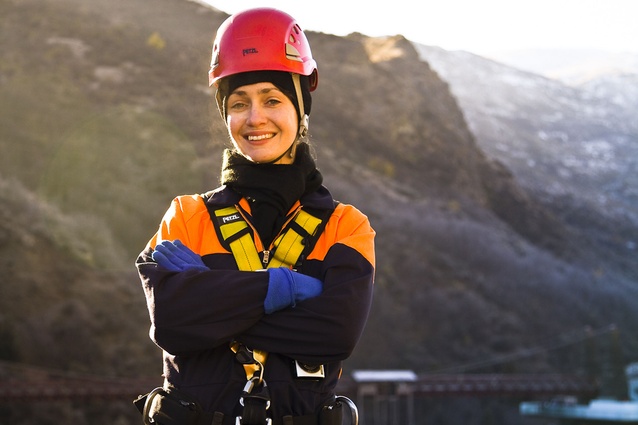The high life
Abseiling rock faces and flying in helicopters is all in a day’s work for Emily Stevens, geotechnical engineer for Opus International and recipient of the prestigious Association of Consulting Engineers Future Leader Award 2014. The 32-year-old is based in Queenstown and works on some unusual and challenging projects.
The central Otago environment is rugged, and for engineers, there are a lot of hazards, Stevens says. The Future Leader Award recognised her strong leadership skills managing teams that work in high-risk situations following slip and rockfall events on the state highways.
The main project she works on concerns a major rock fall hazard at Nevis Bluff on State Highway 6 between Queenstown and Cromwell. The bluff is approximately 500 metres long by 120 metres high. The road has been vulnerable at this location to rock falls and slips since it was cut through in the mid-1800s, Stevens says. Recent major failures occurred in 1975 and 2000. In 2000, Opus International Consultants took on regular monitoring and maintenance for the New Zealand Transport Agency (NZTA).
“My job involves designing the remedial measures and overseeing operations on site. We monitor the bluff once a month from a helicopter and decide which features need remediation. It is satisfying work and I enjoy the technical and logistical complexities of the project. Everyone in the local community has a solution or an opinion about the site,” she says.
The Diana Falls Slip in the Haast Pass is another project that Stevens has been involved with as the geotechnical engineer for the initial incident response, and geotechnical advisor to NZTA. This slip occurred after around 300mm of rain fell in a 24-hour period in September 2013, and is around 300 metres high. The project is the only one of its kind in the southern hemisphere, using large barriers to contain and direct the material of a large slip poised on State Highway 6 between Makarora and Haast. The barriers are three attenuators of very high capacity – 3000 to 5000 kilojoules and up to six metres high.
“The slip is very complex with boulders the size of vans. There are tension cracks above the current headscarp and currently we don’t know when it is going to stop. Working in high-pressure situations such as the Diana Falls Slip incident response phase is something that doesn’t phase me. I appreciate challenges.”
Stevens was also involved with site investigations and foundation assessments immediately after the Canterbury earthquakes. She inspected rock fall zones and did rock mapping in the Port Hills and Sumner.
Stevens grew up in Whanganui and says she was a good all rounder at school, choosing the sciences as most promising for career options and preferring to do applied science rather than work in a laboratory. She completed a Bachelor of Civil Engineering with first class honours at the University of Canterbury, followed by a Masters of Civil Engineering Management. She has worked for Opus for eight years in Whanganui, Wellington and Queenstown.
She enjoys the practical, outdoorsy aspects of engineering – “abseiling is pretty fun” – as well as the creative side of the job. “I enjoy solving problems, and it’s satisfying making the world a safer place – helping people continue on their journey, even though they may not have any idea of the work we are doing or why we are doing it.”
Since mid-2013, Stevens has led the Geotechnical Professional Interest Network within Opus as the group’s chair, overseeing the technical wellbeing of around 200 professionals worldwide. She is the current Central Otago representative for the Institution of Professional Engineers New Zealand and says she is passionate about women in engineering reaching management roles.
“Personally, I find it incredibly inspirational to look up to female engineers in senior management positions”
And, using her skills to give back to the world, she is involved in the Queenstown Lakes Buddy Programme, and travels to Peru and Samoa to take part in charity projects. “I enjoy doing this and will continue to seek, and be involved in, opportunities like this throughout the rest of my career.”
And career plans for the future? “I love living in Queenstown so I’m quite settled in my base here. I enjoy organising and doing a bit of strategy. I’m really looking forward to doing the one-year Young Professionals Management Training programme with the International Federation of Consulting Engineers and going to the international conference next year with other engineering professionals from around the world, which will be amazing. The focus will be on management within the engineering industry so I’m keen to further that interest and see where it can take me – to learn more skills and continue with my professional development.”











